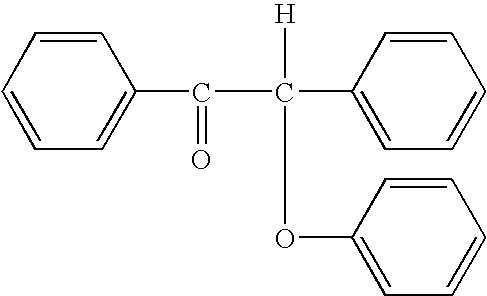Pattern forming method, image forming method, fine particle adsorption pattern forming method, conductive pattern forming method, pattern forming material and planographic printing plate
a technology of conductive pattern and pattern forming, which is applied in the field of pattern forming method, image forming method, fine particle adsorption pattern forming method, etc., can solve the problems of difficult application of method to large area image formation and the like, unsatisfactory quality and resolution of formed image, and work is troublesome, so as to improve the adhesion property of fine particles and improve the adhesion property of conductive materials. , the effect of superior conductivity
- Summary
- Abstract
- Description
- Claims
- Application Information
AI Technical Summary
Benefits of technology
Problems solved by technology
Method used
Image
Examples
synthesis example 1
(Synthesis of Specific Polymerization Initiation Polymer A)
[0416]To a 300 ml three necked flask, 30 g of propylene glycol monomethyl ether (MFG) was added to be heated at 75° C. Thereto, a solution of 8.1 g of [2-(acryloyloxy)ethyl](4-benzoylbenzyl)dimethylammonium bromide, 9.9 g of 2-hydroxyethyl methacrylate, 13.5 g of isopropyl methacrylate, 0.43 g of dimethyl-2,2′-azobis(2-methyl propionate) and 30 g of MFG was added dropwise over 2.5 hours. Then, the reaction temperature was raised to 80° C., and further reaction was made for 2 hours to obtain the specific polymerization initiation polymer A described below. The numerical values shown in the following structures show the molar copolymerization ratio of respective repeating units.
[0417]
synthesis example 2
(Synthesis of Specific Polymerization Initiation Polymer B)
[0418]To a 300 ml three necked flask, 30 g of propylene glycol monomethyl ether (MFG) was added to be heated at 75° C. Thereto, a solution of 5.1 g of 4-methacryloyloxy-benzophenone, 9.9 g of 2-hydroxyethyl methacrylate, 9.8 g of isopropyl methacrylate, 3.97 g of [2-(methacryloyloxy)ethyl]trimethylammonium bromide, 0.43 g of dimethyl-2,2′-azobis(2-methyl propionate) and 30 g of propylene glycol monomethyl ether (MFG) was added dropwise over 2.5 hours. Then, the reaction temperature was raised to 80° C., and further reaction was made for 2 hours to obtain the specific polymerization initiation polymer B described below. The numerical values shown in the following structures show the molar copolymerization ratio of respective repeating units.
[0419]
synthesis example 3
(Synthesis of Specific Polymerization Initiation Polymer C)
[0420]To a 300 ml three necked flask, 30 g of propylene glycol monomethyl ether (MFG) was added to be heated at 75° C. Thereto, a solution of 8.1 g of [2-(acryloyloxy)ethyl](4-benzoylbenzyl)dimethylammonium bromide, 9.9 g of 2-aminoethyl methacrylate, 13.5 g of isopropyl methacrylate, 0.43 g of dimethyl-2,2′-azobis(2-methyl propionate) and 30 g of propylene glycol monomethyl ether (MFG) was added dropwise over 2.5 hours. Then, the reaction temperature was raised to 80° C., and further reaction was made for 2 hours to obtain the specific polymerization initiation polymer C described below. The numerical values shown in the following structures show the molar copolymerization ratio of respective repeating units.
[0421]
1. Examples related to pattern forming method, image forming method, pattern forming material, and planographic printing plate
PUM
| Property | Measurement | Unit |
|---|---|---|
| temperature | aaaaa | aaaaa |
| wavelength | aaaaa | aaaaa |
| temperature | aaaaa | aaaaa |
Abstract
Description
Claims
Application Information
 Login to View More
Login to View More - R&D
- Intellectual Property
- Life Sciences
- Materials
- Tech Scout
- Unparalleled Data Quality
- Higher Quality Content
- 60% Fewer Hallucinations
Browse by: Latest US Patents, China's latest patents, Technical Efficacy Thesaurus, Application Domain, Technology Topic, Popular Technical Reports.
© 2025 PatSnap. All rights reserved.Legal|Privacy policy|Modern Slavery Act Transparency Statement|Sitemap|About US| Contact US: help@patsnap.com



